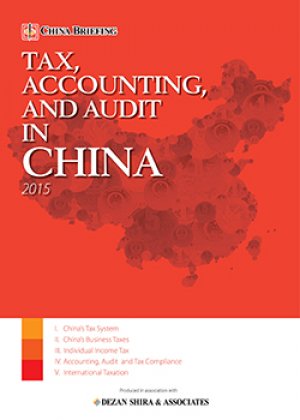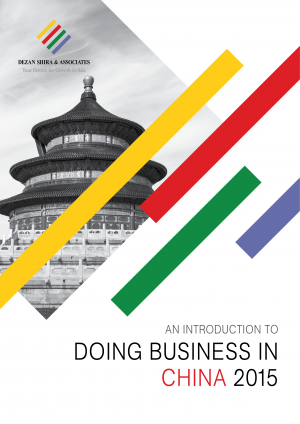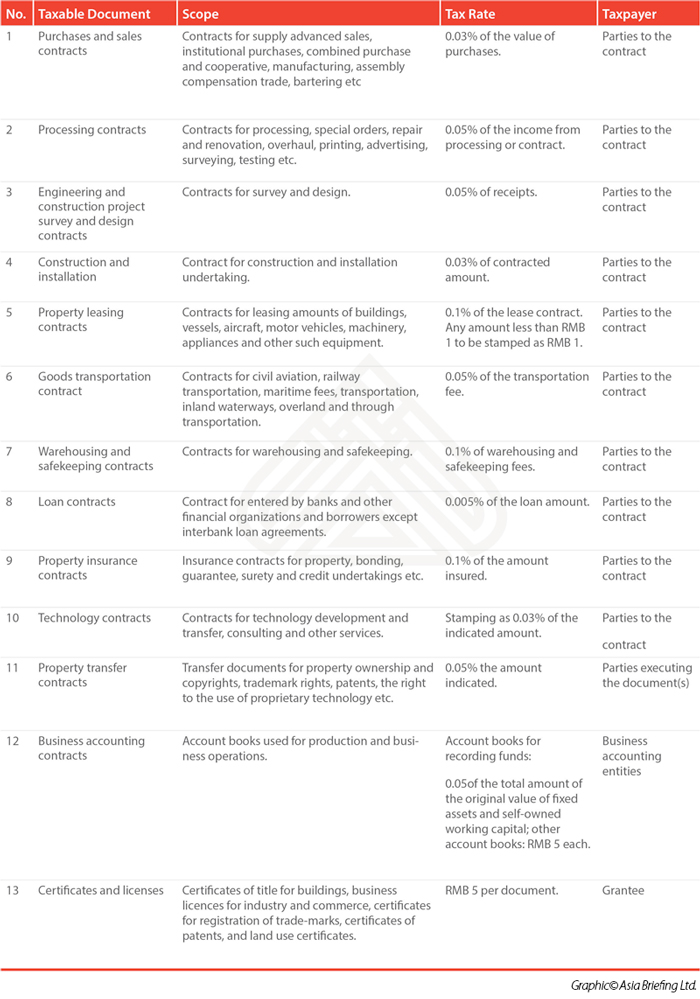A Guide to China’s Stamp Duty
By Dezan Shira & Associates
Editor: Jake Liddle
China levies stamp duty (印花税) on legal documents as in many other countries. Rules and regulations regarding Stamp Duty are primarily stipulated in the State Council’s Provisional Rules of the People’s Republic of China on Stamp Duty (1988). However, many foreign investors are unfamiliar with China’s stamp duty, which can open them up to penalties due to neglect or late payments.
Although stamp duty is not a major tax for most taxpayers, compliance with China’s regulations should always be a key concern for foreign companies. Non-compliance or underpayment will result in a fine of up to 30 times tax payable. In order to avoid such a penalty, investors should take heed of the key rules as outlined in this article.
Taxable Documents
Stamp duty is a form of tax applied to certain written documents in China , or on licenses or certification granted by the administrative authority. The following categories of documents are subject to stamp duty:
- Documents issued for purchase and sale transactions, process contracting, property leasing, commodity transportation, storage and custody of goods, loans, property insurance, technology contracts and other documents of a contractual nature;
- Documents of transfer of property title;
- Business books of account;
- Documentation of rights or licenses;
- Other documents determined by the Ministry of Finance to be taxable.
 RELATED: Tax and Compliance Services from Dezan Shira & Associates
RELATED: Tax and Compliance Services from Dezan Shira & Associates
Exemption
The following documents are exempt from stamp duty:
- Duplicate copies or written copies of documents on which stamp duty has already been paid;
- Documentation in a case where a property owner donates property to the government, a social welfare unit or school;
- Other documents which the Ministry of Finance approves as being exempt from stamp duty.
If tax payable does not amount to more than RMB 0.1, it is also exempt from stamp duty. Where the tax payable exceeds RMB 0.1 and the second number after the decimal is less than five (e.g., the tax payable is RMB 0.13), the taxpayer may round the number to RMB 0.1. Conversely, if the second number after the decimal is greater than or equal to five (e.g., the tax payable is RMB 0.17), the taxpayer needs to round the number up and pay stamp duty based on the new value (e.g., RMB 0.17 rounded to RMB 0.2).
Payment Process
Tax payable is calculated in RMB. Therefore, where a payment indicated in taxable documents is presented as a foreign currency, it should be converted into RMB in accordance with the exchange rate provided by the People’s Bank of China on the signing date of the document. All signing parties associated with a contract are legally obliged to pay stamp duty. Where tax payable exceeds RMB 500, the taxpayer may use payment certificates after receiving authorization from the tax authority, or tax may be paid at a later date, within and not exceeding one month.
Taxpayers must calculate the amount of tax payable in accordance with the nature of the taxable documents, as calculations are either based on the proportional tax rate, or in accordance with the quota amount, as seen below:
Tax Payable = Amount of payment (or fees or revenue) indicated in taxable documents x Applicable rate
or
Tax Payable = Number of pieces of taxable documents X Amount of tax per unit
Determination of calculation should be informed by the following Stamp Duty tariff table which details the thirteen taxable items, their relevant tax rates, and the responsible taxpayer:
|
Asia Briefing Ltd. is a subsidiary of Dezan Shira & Associates. Dezan Shira is a specialist foreign direct investment practice, providing corporate establishment, business advisory, tax advisory and compliance, accounting, payroll, due diligence and financial review services to multinationals investing in China, Hong Kong, India, Vietnam, Singapore and the rest of ASEAN. For further information, please email china@dezshira.com or visit www.dezshira.com. Stay up to date with the latest business and investment trends in Asia by subscribing to our complimentary update service featuring news, commentary and regulatory insight.
|
![]()
 Tax, Accounting, and Audit in China 2015
Tax, Accounting, and Audit in China 2015
This edition of Tax, Accounting, and Audit in China, updated for 2015, offers a comprehensive overview of the major taxes foreign investors are likely to encounter when establishing or operating a business in China, as well as other tax-relevant obligations. This concise, detailed, yet pragmatic guide is ideal for CFOs, compliance officers and heads of accounting who must navigate the complex tax and accounting landscape in China in order to effectively manage and strategically plan their China operations.
 An Introduction to Doing Business in China 2015
An Introduction to Doing Business in China 2015
Doing Business in China 2015 is designed to introduce the fundamentals of investing in China. Compiled by the professionals at Dezan Shira & Associates, this comprehensive guide is ideal not only for businesses looking to enter the Chinese market, but also for companies that already have a presence here and want to keep up-to-date with the most recent and relevant policy changes.
 Annual Audit and Compliance in China 2016
Annual Audit and Compliance in China 2016
In this issue of China Briefing, we provide a comprehensive analysis of the various annual compliance procedures that foreign invested enterprises in China will have to follow, including wholly-foreign owned enterprises, joint ventures, foreign-invested commercial enterprises, and representative offices. We include a step-by-step guide to these procedures, list out the annual compliance timeline, detail the latest changes to China’s standards, and finally explain why China’s audit should be started as early as possible.
- Previous Article China veröffentlicht den neuen Entwurf über die Regelung der Verrechnungspreisdokumentation
- Next Article Steuerliche Aspekte für Software-Geschäfte in China



























